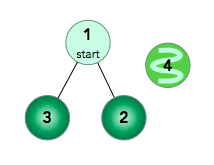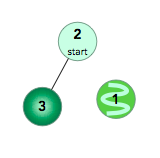Consider an undirected graph consisting of nodes where each node is labeled from to and the edge between any two nodes is always of length . We define node to be the starting position for a BFS.
Given queries in the form of a graph and some starting node, , perform each query by calculating the shortest distance from starting node to all the other nodes in the graph. Then print a single line of space-separated integers listing node 's shortest distance to each of the other nodes (ordered sequentially by node number); if is disconnected from a node, print as the distance to that node.
Input Format
The first line contains an integer, , denoting the number of queries. The subsequent lines describe each query in the following format:
- The first line contains two space-separated integers describing the respective values of (the number of nodes) and (the number of edges) in the graph.
- Each line of the subsequent lines contains two space-separated integers, and , describing an edge connecting node to node .
- The last line contains a single integer, , denoting the index of the starting node.
Constraints
Output Format
For each of the queries, print a single line of space-separated integers denoting the shortest distances to each of the other nodes from starting position . These distances should be listed sequentially by node number (i.e., ), but should not include node . If some node is unreachable from , print as the distance to that node.
Sample Input
2
4 2
1 2
1 3
1
3 1
2 3
2
Sample Output
6 6 -1
-1 6
Explanation
We perform the following two queries:
- The given graph can be represented as:

where our start node, , is node . The shortest distances from to the other nodes are one edge to node , one edge to node , and an infinite distance to node (which it's not connected to). We then print node 's distance to nodes , , and (respectively) as a single line of space-separated integers:6 6 -1. - The given graph can be represented as:

where our start node, , is node . There is only one edge here, so node is unreachable from node and node has one edge connecting it to node . We then print node 's distance to nodes and (respectively) as a single line of space-separated integers:-1 6.
Note: Recall that the actual length of each edge is , and we print as the distance to any node that's unreachable from .
CODE: Click here
Comments
Post a Comment